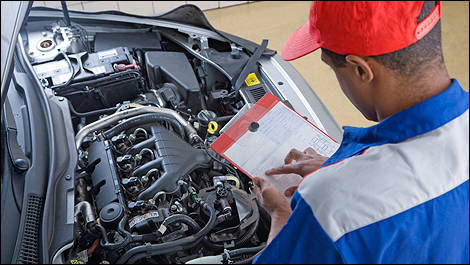Fluids are the lifeblood of any vehicle and allow the engine and other systems to operate properly and deliver optimum performance. Among their many different assignments they lubricate, cool down, pressurize, clean, and even help reduce emissions.
You must use the right products and perform regular checkups to make sure all fluids are up to the task.
Engine oil
Every engine needs a specific amount of oil. Typically, you'll find a dipstick with the minimum and maximum levels of oil required for the tank. When you need to add fresh oil, fill it up until you reach the top line.
A couple of times per month, check the oil a short while after running the engine for at least 10 minutes and turning it off. Watch out for leaks! Ideally, you should add no more than 250 ml at a time.
Brake fluid
This fluid generates a pressure on the brake piston, pushing the pads onto the disc. In many of today's vehicles, an exclamation mark will light up on the dashboard when the tank needs filling. How does that happen? Well, it usually means the pads are worn out, since the brake fluid has to travel a longer distance to reach the piston as the pads become thinner.
The clear tank is found inside the engine bay. Do not apply the brakes during your checkup. Add fresh fluid up to the maximum level line is. Then, go see a mechanic to have your brake pads inspected.
Transmission oil
Either red (automatic) or brownish (manual), this oil lubricates every component of the transmission. If your vehicle doesn't come with a transmission oil dipstick, you need to call on a mechanic. A low level often signals a leak.
Whenever you feel like the transmission is more reluctant to get into gear, you should perform a checkup, but only with the engine still running. In most cases, the oil tank for a manual transmission is harder to access, and therefore must be filled by a specialist.
Coolant
This fluid is vital to your engine's performance, especially during hotter months. If there's been overheating or if the cylinder head gasket is no longer perfectly sealed, coolant will be burned and expelled through the exhaust system. Never touch the radiator cap when it’s hot!
There are many different types of cooling systems that use different types of coolant. Your best bet is to follow the manufacturer's recommendation in your owner's manual. Coolant typically needs to be changed every 60,000 kilometres or so.
Power steering fluid
This other tank is also found inside the engine bay, with a steering wheel icon on the cap (which is tied to a dipstick). In some vehicles, a light will turn on within the instrument cluster when the fluid drops below the minimum level.
Power steering fluid expands when heated, so you need to adjust based on the engine's temperature. Use the manufacturer's recommended fluid to avoid any problems.
Differential/transfer case oil (AWD/4WD vehicles)
This fluid is the same that manual transmissions use. Occasionally, ask a mechanic to check its condition.
Emission control system fluid
In some cases, mostly with diesel engines, a urea-based liquid is added to further eliminate toxic particles coming out of the catalytic converter. To be safe, you should fill the tank every time you change your engine oil. Otherwise, when it runs empty, the engine simply won't start!
Windshield washer fluid
Driving safely requires a clear field of vision. As a precaution, always carry a spare bottle of windshield washer fluid in your car, especially during winter.
Fuel
Last, but certainly not least, is the liquid that makes your vehicle go. During the cold season, you shouldn't let the fuel tank carry less than a quarter of its capacity to prevent humidity, which can build up in the fuel lines and freeze them.
You must use the right products and perform regular checkups to make sure all fluids are up to the task.
 |
Engine oil
Every engine needs a specific amount of oil. Typically, you'll find a dipstick with the minimum and maximum levels of oil required for the tank. When you need to add fresh oil, fill it up until you reach the top line.
A couple of times per month, check the oil a short while after running the engine for at least 10 minutes and turning it off. Watch out for leaks! Ideally, you should add no more than 250 ml at a time.
Brake fluid
This fluid generates a pressure on the brake piston, pushing the pads onto the disc. In many of today's vehicles, an exclamation mark will light up on the dashboard when the tank needs filling. How does that happen? Well, it usually means the pads are worn out, since the brake fluid has to travel a longer distance to reach the piston as the pads become thinner.
The clear tank is found inside the engine bay. Do not apply the brakes during your checkup. Add fresh fluid up to the maximum level line is. Then, go see a mechanic to have your brake pads inspected.
Transmission oil
Either red (automatic) or brownish (manual), this oil lubricates every component of the transmission. If your vehicle doesn't come with a transmission oil dipstick, you need to call on a mechanic. A low level often signals a leak.
Whenever you feel like the transmission is more reluctant to get into gear, you should perform a checkup, but only with the engine still running. In most cases, the oil tank for a manual transmission is harder to access, and therefore must be filled by a specialist.
Coolant
This fluid is vital to your engine's performance, especially during hotter months. If there's been overheating or if the cylinder head gasket is no longer perfectly sealed, coolant will be burned and expelled through the exhaust system. Never touch the radiator cap when it’s hot!
There are many different types of cooling systems that use different types of coolant. Your best bet is to follow the manufacturer's recommendation in your owner's manual. Coolant typically needs to be changed every 60,000 kilometres or so.
Power steering fluid
This other tank is also found inside the engine bay, with a steering wheel icon on the cap (which is tied to a dipstick). In some vehicles, a light will turn on within the instrument cluster when the fluid drops below the minimum level.
Power steering fluid expands when heated, so you need to adjust based on the engine's temperature. Use the manufacturer's recommended fluid to avoid any problems.
Differential/transfer case oil (AWD/4WD vehicles)
This fluid is the same that manual transmissions use. Occasionally, ask a mechanic to check its condition.
Emission control system fluid
In some cases, mostly with diesel engines, a urea-based liquid is added to further eliminate toxic particles coming out of the catalytic converter. To be safe, you should fill the tank every time you change your engine oil. Otherwise, when it runs empty, the engine simply won't start!
Windshield washer fluid
Driving safely requires a clear field of vision. As a precaution, always carry a spare bottle of windshield washer fluid in your car, especially during winter.
Fuel
Last, but certainly not least, is the liquid that makes your vehicle go. During the cold season, you shouldn't let the fuel tank carry less than a quarter of its capacity to prevent humidity, which can build up in the fuel lines and freeze them.


